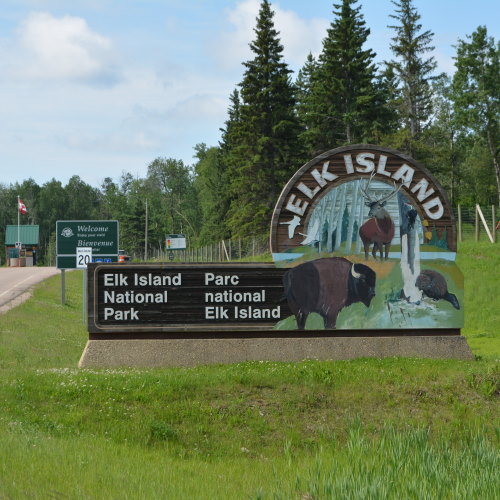Chalk one up for us little guys.
I regularly mock massive RV owners. Usually just in my head. And certainly never in person. It’s one of those petty judgments we all secretly relish.
I am well aware that they are by far in the majority when it comes to travel trailer choice. The storage lots and dealerships are overflowing with giant fifth wheels and grandiose toy haulers. They are a sight to behold. I just don’t understand them. Costly, horrible for gas mileage, and difficult to maneuver, they’re essentially cottages on wheels. Maybe that’s the appeal?
Personally, I prefer a more authentic outdoors experience, though I’m sure tent campers are equally judgmental of my 16’ Geo Pro. There’s always someone more legit, yo.
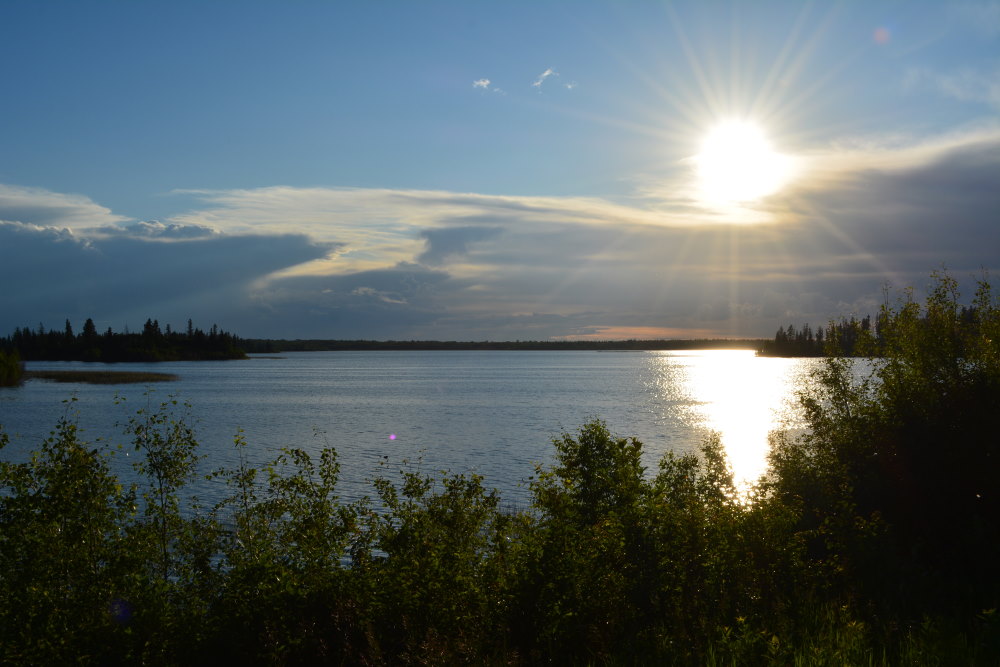
There is one thing tenters and small RVers can agree upon, though, and that’s that Astotin Lake Campground in Elk Island National Park is just for us little guys. Not by any decree, mind you, but rather the product of geography and, presumably, vintage design.
Located approximately 35 km east of Edmonton, Alberta, Elk Island is an unexpected national park in both size and location. Encompassing 194 square kilometres of the Beaver Hills, a hummocky glacial moraine on the edge of the prairies, the park doesn’t extol the impressive grandeur of the more famous mountain parks to the west nor does it have the quaint feel of a “we need to give this province a national park of some kind” some lesser known parks exude.
Which isn’t to say Elk Island National Park is ugly or unnecessary; just that it’s a bit surprising it exists in the first place. I’d never heard of it until I moved to Alberta and even then it garnered an inquisitive double-take when friends suggested camping there.
It ended up being one of the first camping trips we took after purchasing our first RV several years ago, and this year we decided to return for three days as veteran campers. We were curious to re-experience Elk Island National Park and hopefully enjoy some Canada Day celebrations on the July 1st Monday of our departure. Hey, they advertised cake!
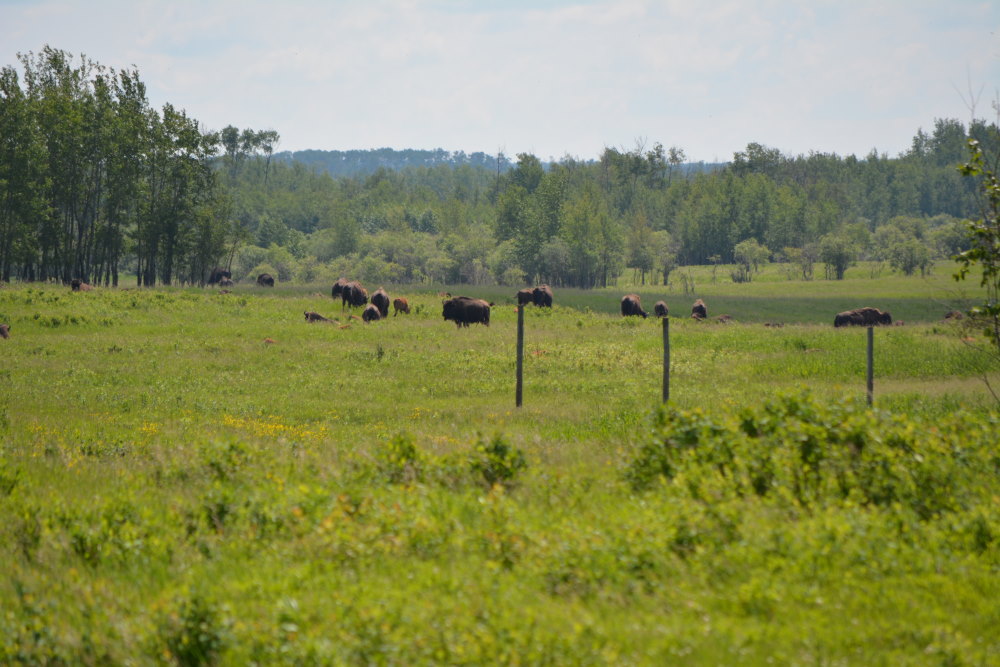
Elk Island National Park is ground zero for Canada’s bison preservation efforts. The original home for one of the very last surviving disease-free plains bison herds in the world, Elk Island has been instrumental in the slow but steady re-introduction of this magnificent species across North America.
With approximately 400 plains bison and 300 wood bison, living wild within the park boundaries, Elk Island is a handy place to see and learn about these herbivores that once numbered in the tens of millions but were brought to the brink of extinction by the start of the previous century.
 Tours of the medical and relocation facilities situated next to the Visitor’s Centre close the entrance off Highway 16 are available daily and offer an informative look into how the bison are cared for and ultimately re-introduced to other parks, wilderness areas, and ranches across the continent (and sometimes around the globe).
Tours of the medical and relocation facilities situated next to the Visitor’s Centre close the entrance off Highway 16 are available daily and offer an informative look into how the bison are cared for and ultimately re-introduced to other parks, wilderness areas, and ranches across the continent (and sometimes around the globe).
We enjoyed one of these tours that took us to the roundup pens and into the treatment building where the animals are vaccinated, tagged, and cared for during their time at Elk Island National Park. The tour is reasonable in length, requires only a little walking, and is full of interesting facts and visuals.
The Visitor Centre offers additional information about bison, as well as the park itself (this is where you go for back-country camping and hiking guidance from park rangers), while also offering plenty of books and bison-themed souvenirs for purchase.
An opportunity to see the actual bison can occur at almost any time. They wander the park and often you will come across one or two munching on ditch grass alongside the road during the 12km drive from highway 16 to Astotin Lake.
Furthermore, the Bison Loop road is a 3km loop into a meadow that the bison herd is known to occupy regularly. A drive through here often provides a nice view of a larger herd of plains bison (the larger wood bison are located south of highway 16 only). They are shy creatures, preferring to stay away from people so you might want to have binoculars or a zoom lens on your camera.
Our drive through the Bison Loop was moderately successful. We saw a herd of bison off in the distance but they weren’t close enough to get that “wow” moment with just our eyesight. The zoom lens on my camera enabled a decent picture but it would have been nice to have them closer. A park guide was present discussing bison with guests which was a nice touch.
Bison aren’t the only wild inhabitants of Elk Island National Park. There are Elk, of course. The park was originally created as a protected area for Elk long before the bison took up residence. Elk were also at risk and dwindling in number due to over-hunting and disease and this “island” refuge was created to help them. Perhaps ironically, we didn’t see any.
We did, however, see plenty of birds. The rolling hills of forest and meadow dotted with myriad lakes, bogs, and sloughs makes Elk Island a paradise for local and migrating bird populations. We saw pelicans, geese, ducks, grebes, osprey, and swallows flying, eating, hunting, and nesting all over the park. With several species of each to be found, it’s a birder’s dream and photo ops abound.
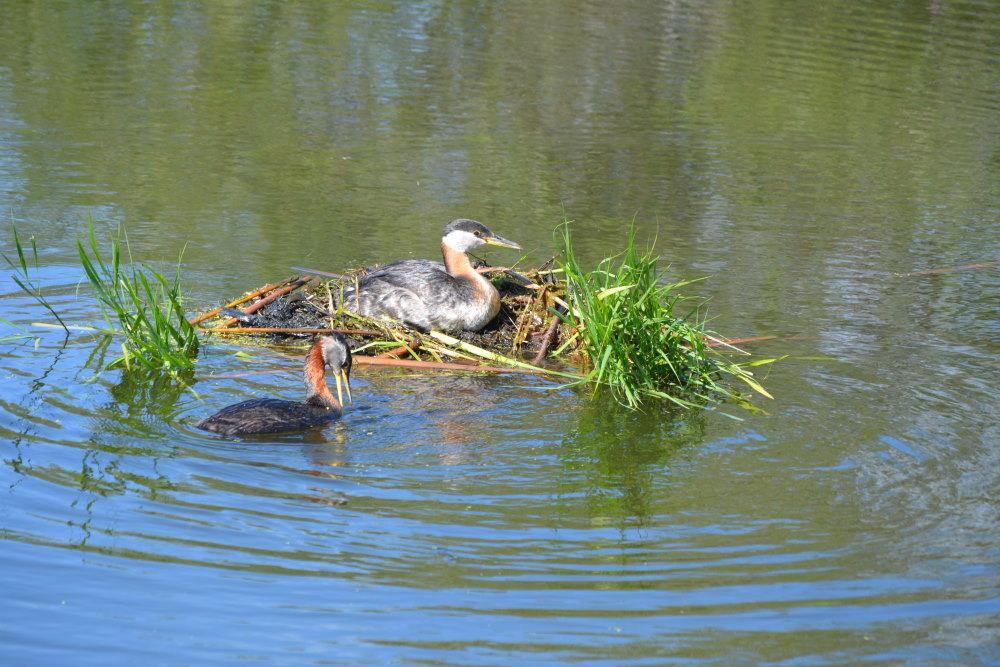
The highlight of our birdwatching was the red-headed grebe couple nesting on a solitary mound a few feet from the floating boardwalk on Astotin Lake. The female was sitting on five speckled eggs and the male was busily reinforcing the nesting mound which was struggling to stay above the rising water resulting from all the spring rains.
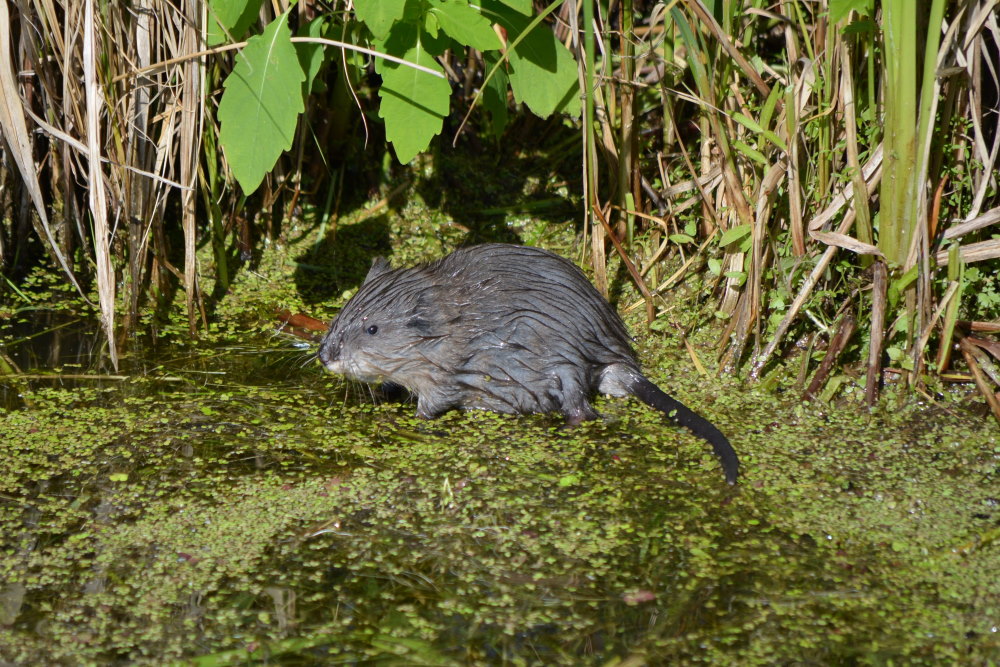
Or maybe the highlight was the round, grey, rat-tailed creature we spotted in the reeds to the side of the same boardwalk. We had never seen anything like it before and knew not what it was. It looked both beaverish and guinea piggish. Turns out it was a muskrat, a surprisingly cute and compact critter I had always assumed was more otter-like.
 The six pelicans that took off from the far side of a small bay, directly towards me on the boardwalk, each taking flight one after the other like a B52 bomber squadron, was a close runner-up.
The six pelicans that took off from the far side of a small bay, directly towards me on the boardwalk, each taking flight one after the other like a B52 bomber squadron, was a close runner-up.
This floating boardwalk I’ve just raved about exists on the east shore of Astotin Lake. This lake, the largest in the park, is truly the hub of recreational activities at Elk Island National Park. The developed area on the east side of the lake is essentially one magnificent day-use area that happens to have a small campground in it.
This brings me back to my initial comments on RV size. Size really does matter here because Astotin Lake Campground is one of the most unique campground layouts I’ve ever encountered. And by unique I mostly mean, small. Big RVs just won’t fit anywhere here.

The main campground harkens to a time when most campers used tents or smallish trailers. It is an undulating, curvy, forested campground comprised of a single, wandering loop. Sites of varying size and orientation are placed with no rhyme or reason. Some are close beside each other while others have more space. None I would describe as spacious or private. And maybe, MAYBE, one or two could fit a 25’ trailer and tow vehicle.
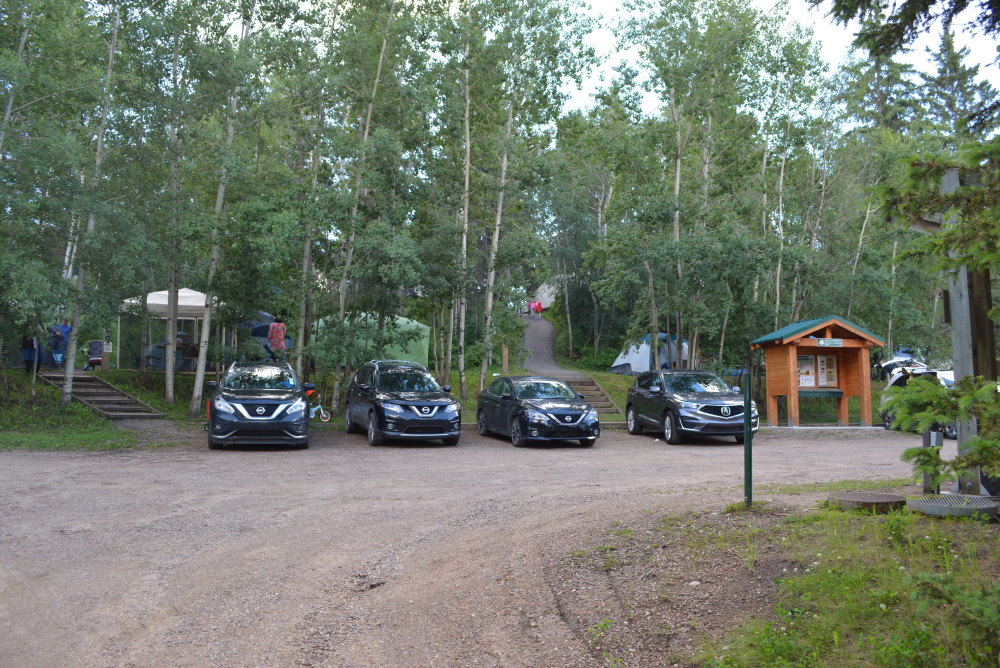
The bulk of the 40 sites in the main Astotin Lake Campground are suitable for small trailers and tents only, including a few walk-in tent areas and a couple oTentik sites. Nor do any of the sites have power or water (or sewer). It’s an old school, rustic kind of campground but with a large, modern bathroom and shower building in its midst. Yay, no pit toilets!
A little further up the road is an RV designated campground which I thought would surely have large pull-through sites for modern-day fifth wheels and motorhomes. But it too is shockingly small and certainly not an appealing camping spot. Comprised of 23 sites in a single, oblong loop with a grassy area down the centre and concrete enclaves around the outside, I don’t understand why this is specifically described as an RV spot.

 You could possible manoeuvre a tent trailer into one of the concrete sites the likes of which I’ve never seen before. But large units would only fit alongside the green space and only then, if the place is empty. Even when they do attempt to cater to large RVs they only tease at it. Oh, and not only do these poor folks not have a shower house, there have the cutest single unit outhouse I’ve ever seen. Lucky ducks.
You could possible manoeuvre a tent trailer into one of the concrete sites the likes of which I’ve never seen before. But large units would only fit alongside the green space and only then, if the place is empty. Even when they do attempt to cater to large RVs they only tease at it. Oh, and not only do these poor folks not have a shower house, there have the cutest single unit outhouse I’ve ever seen. Lucky ducks.
 In addition to the walk-in tent spots within the main Astotin Lake Campground, there is an additional stand-alone walk-in tenting area between campground proper and the RV area. I had a peak in and it seems like a nice, wooded area with green spaces for 15 tents on multi-levels within.
In addition to the walk-in tent spots within the main Astotin Lake Campground, there is an additional stand-alone walk-in tenting area between campground proper and the RV area. I had a peak in and it seems like a nice, wooded area with green spaces for 15 tents on multi-levels within.
As I mentioned, despite having no services on sites, Astotin Lake Campground does have a lovely shower house with outdoor kitchen cleanup station. It is located in a somewhat central area that is accessible from all corners of this tiny campground. You can walk along the loop road or take one of the narrow, paved trails that cut across the centre of the loop.
 There are two shower stalls and while they are free they do employ the push button style control which removes the ability to adjust water temperature and requires that you regularly push the button to get water. The hot
There are two shower stalls and while they are free they do employ the push button style control which removes the ability to adjust water temperature and requires that you regularly push the button to get water. The hot  water is hit or miss. If others are in the adjoining stalls it feels like the two showers are battling for the hot water and it will alternate between cool and warm. Not too cold to shower in but not comfortable either. On a second occasion, I showered alone and was rewarded with a delightful shower experience.
water is hit or miss. If others are in the adjoining stalls it feels like the two showers are battling for the hot water and it will alternate between cool and warm. Not too cold to shower in but not comfortable either. On a second occasion, I showered alone and was rewarded with a delightful shower experience.
I must take a moment to say something here. Elk Island has got the greatest toilet paper I have ever had the pleasure to use in a government-operated facility. That stuff felt like 20 ply, man! So much nicer than the single-ply garbage that your fingers puncture with the slightest pressure.
 Firewood stalls are found at several locations around the campground. Wood is sold as a daily burn permit for $8. This is a great deal if you use lots of wood. It’s a terrible deal if you believe it promotes wanton release of carbon into an already stressed atmosphere.
Firewood stalls are found at several locations around the campground. Wood is sold as a daily burn permit for $8. This is a great deal if you use lots of wood. It’s a terrible deal if you believe it promotes wanton release of carbon into an already stressed atmosphere.
 We found the firewood at Astotin Lake Campground terrible for burning. It is mostly aspen and spruce with some birch hidden in there. At the time of our stay, all the wood was wet and/or green and didn’t burn well at all. It was almost impossible to light and difficult to keep going. I spent two hours one afternoon trying to get a fire going to cook two hot dogs. That’s not a good use of vacation time.
We found the firewood at Astotin Lake Campground terrible for burning. It is mostly aspen and spruce with some birch hidden in there. At the time of our stay, all the wood was wet and/or green and didn’t burn well at all. It was almost impossible to light and difficult to keep going. I spent two hours one afternoon trying to get a fire going to cook two hot dogs. That’s not a good use of vacation time.
A large picnic shelter is located at the north end of the campground loop near some tenting sites. This is a spectacular structure with a wood stove, power, and lighting. It offers shelter during storms and is a great place for group gatherings. We are not sure if this particular shelter is solely for the use of campers or if it can be booked by folks not camping in the loop. It would be odd if the latter was true but we can’t emphatically say that all the people we saw using it during our stay also had campsites.
 A small but modern, metal playground exists right behind this large picnic shelter. It’s not exclusive to the picnic shelter users but undoubtedly a convenient perk for them. It is small, though, and bigger kids will bore of it quickly. Still, it’s a nice addition for families celebrating there as well as those staying in the campground.
A small but modern, metal playground exists right behind this large picnic shelter. It’s not exclusive to the picnic shelter users but undoubtedly a convenient perk for them. It is small, though, and bigger kids will bore of it quickly. Still, it’s a nice addition for families celebrating there as well as those staying in the campground.
Fresh water taps are located at the various wood bins around the campground. The water is tasty, but the taps are odd brass things that don’t stay open and have no means for a hose to be attached to them. Not a huge issue as these aren’t meant for such use but be aware you will need to fill up your trailer tank at the dump station.
 That dump station is a single outlet hidden away near the new registration office found over by the day use area, away from the campground. A single station doesn’t offer much confidence for quick exits on departure day, but with the limited camping sites available, it likely doesn’t need to be bigger.
That dump station is a single outlet hidden away near the new registration office found over by the day use area, away from the campground. A single station doesn’t offer much confidence for quick exits on departure day, but with the limited camping sites available, it likely doesn’t need to be bigger.
The registration office is nothing more than that. You buy your burning permit here but  there is no store or anything else for sale. This used to be located at the entrance to the campground but with nothing being added by way of services or amenities, I’m not sure why it moved.
there is no store or anything else for sale. This used to be located at the entrance to the campground but with nothing being added by way of services or amenities, I’m not sure why it moved.
We have now ventured into the raison d’etre of Elk Island. Well, besides the bison. The Astotin Lake recreation area offers visitors one of the most impressive day use areas I’ve yet seen in any national or provincial park.
 A large, paved parking lot welcomes reams of vehicles from the nearby provincial capital. On the weekend we saw a vibrantly decorated school bus offering shuttle rides from Edmonton to Elk Island and back, enabling those without vehicles the chance to enjoy a day at Astotin Lake. I thought that was a great idea. And on one occasion we briefly saw an ice cream truck parked in the lot before an approaching rain storm chased it away.
A large, paved parking lot welcomes reams of vehicles from the nearby provincial capital. On the weekend we saw a vibrantly decorated school bus offering shuttle rides from Edmonton to Elk Island and back, enabling those without vehicles the chance to enjoy a day at Astotin Lake. I thought that was a great idea. And on one occasion we briefly saw an ice cream truck parked in the lot before an approaching rain storm chased it away.
 Surrounding this main parking lot is an expansive grassy area with untold numbers of picnic tables scattered about. Several of the large picnic shelters found in the campground dot the rolling hills around the green area. Each of these has a woodstove, a supply of cut wood, tables, and electricity for entertaining friends and family, day and evening.
Surrounding this main parking lot is an expansive grassy area with untold numbers of picnic tables scattered about. Several of the large picnic shelters found in the campground dot the rolling hills around the green area. Each of these has a woodstove, a supply of cut wood, tables, and electricity for entertaining friends and family, day and evening.
Some of the picnic shelters further afield have their own secondary parking lots to lessen the walk with heavy, stuffed coolers. Additional flush bathroom buildings are found in these areas too. And an array of paved pathways interconnect all quarters of the day use area enabling people to walk or cycle to anyplace they wish to go.
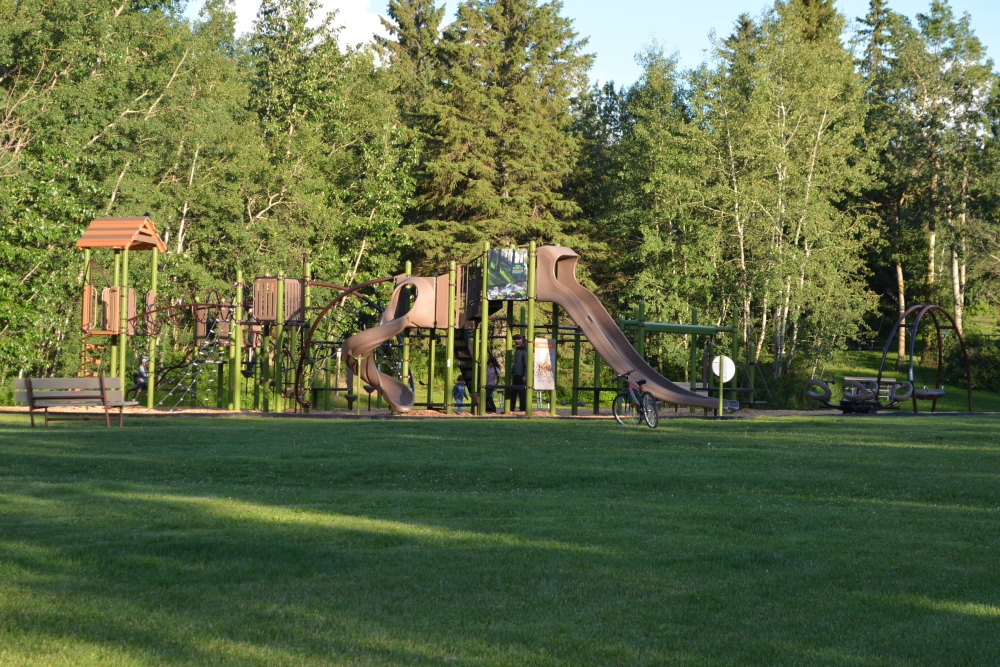
A giant, modern, metal play structure will quickly attract the attention of kids young and old as they explore the day use area. This is an impressive playground and I wish all national parks had ones this extensive. All day and evening this playground is inundated with kids enjoying this impressive structure. Two of them were mine which is becoming a rarer occurrence with each passing year.
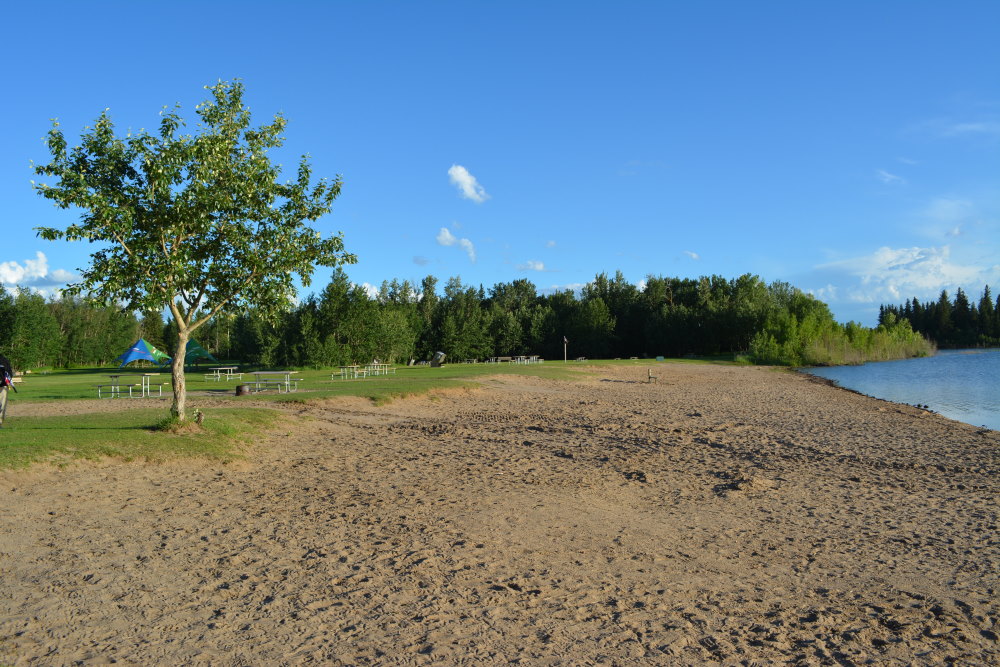
The green space transitions to a beach along the lake immediately in front of the main parking area. I’ll be honest, the beach is  uninspired. It’s mostly sand with a few larger stones and of decent size giving the kids reasonable space to play and dig, but the water’s edge is quite grungy. I really don’t think I would swim in it. And if I did decide to swim, I would jump in from the dock well out and away from the shoreline.
uninspired. It’s mostly sand with a few larger stones and of decent size giving the kids reasonable space to play and dig, but the water’s edge is quite grungy. I really don’t think I would swim in it. And if I did decide to swim, I would jump in from the dock well out and away from the shoreline.
 Instead of swimming, I would make use of the excellent watercraft rental facility at the north end of the beach. Many canoes, paddle boards, and kayaks are available to rent here at reasonable prices. We really wanted to go for a canoe ride but he weather did not cooperate.
Instead of swimming, I would make use of the excellent watercraft rental facility at the north end of the beach. Many canoes, paddle boards, and kayaks are available to rent here at reasonable prices. We really wanted to go for a canoe ride but he weather did not cooperate.
Those of you lucky enough to own your own aforementioned watercraft can launch them from a dock and ramp  found at the north end of the day use area. This launch area has its own parking lot for vehicle storage but take note that motorized boats are not allowed.
found at the north end of the day use area. This launch area has its own parking lot for vehicle storage but take note that motorized boats are not allowed.
Near this launch area (and also one of the picnic shelters) is where you will find the large, sprawling group campsite. It’s basically a parking lot with garbage bins and a pit toilet. A new water tap and nearby flush bathroom have been built but the group site itself remains nothing more than a parking lot. I have no idea why they even bother calling this a group site and it really is a shame because the entire Astotin Lake area would make a great locale for a group camping outing.
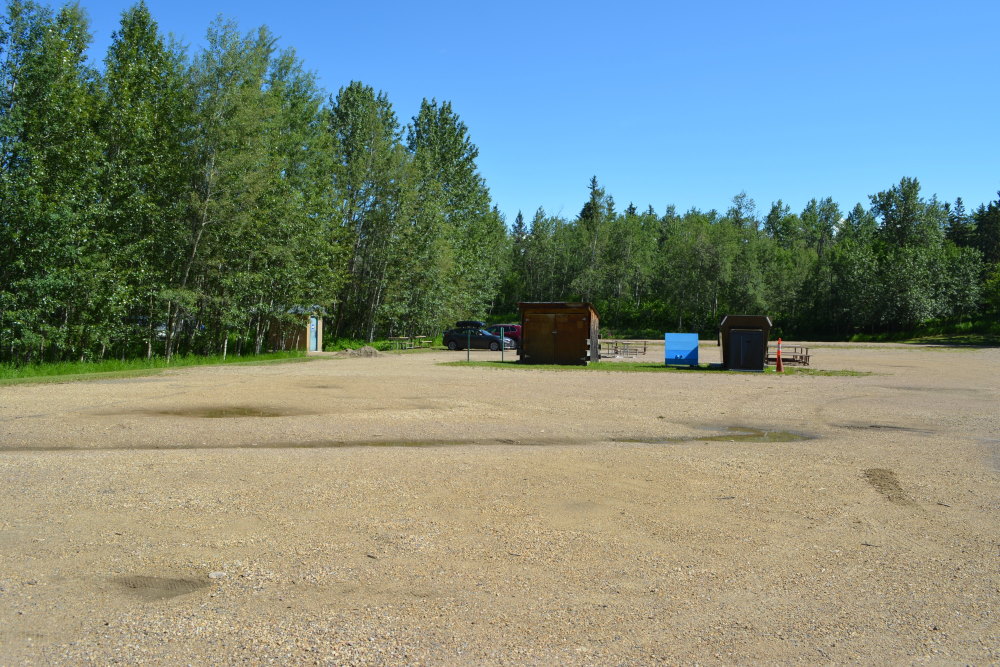
The trails that interconnect the day use area also fan out around Astotin Lake. As I mentioned above, there is the floating boardwalk which is great for viewing waterfowl and critters. But for those wanting a longer hike or even some backcountry camping, there are several trails taking you through the greater Elk Island park grounds.
 Information placards abound at Elk Island National Park. All are legible, informative, and in good condition. This is fantastic for the curious and a welcome surprise after visiting so many parks where these features have been left to deteriorate or been vandalized.
Information placards abound at Elk Island National Park. All are legible, informative, and in good condition. This is fantastic for the curious and a welcome surprise after visiting so many parks where these features have been left to deteriorate or been vandalized.
 If you want something more in-depth than a placard, pop into the Astotin Theatre, located at the south end of the day use area. A large, stand-alone building with stadium-style seating and a small museum inside, the Astotin Theatre is open daily and shows short films about bison and the park at regular intervals. Park staff are there as well to answer questions and share their knowledge of the local flora and fauna.
If you want something more in-depth than a placard, pop into the Astotin Theatre, located at the south end of the day use area. A large, stand-alone building with stadium-style seating and a small museum inside, the Astotin Theatre is open daily and shows short films about bison and the park at regular intervals. Park staff are there as well to answer questions and share their knowledge of the local flora and fauna.
 We saw a ten minute film about the relocation of bison to Banff National Park that occurred a couple years ago. It was an interesting documentary. Unfortunately, our attempt to watch a similar movie about relocating bison to Russia was usurped by a musical group needing to perform a sound check for Canada Day celebrations.
We saw a ten minute film about the relocation of bison to Banff National Park that occurred a couple years ago. It was an interesting documentary. Unfortunately, our attempt to watch a similar movie about relocating bison to Russia was usurped by a musical group needing to perform a sound check for Canada Day celebrations.
 Weather permitting, park staff perform interactive educational shows by a communal fire pit just outside the theatre. We went to the show on Saturday night and were treated to a delightful two-person routine retelling the history of the bison coming to Elk Island National Park. With costumes, voice characterizations and crowd participation, this was a goofy but enlightening 45 minutes of entertainment. And to top it off, we all got s’mores over the fire afterwards. My tax dollars at work in my belly.
Weather permitting, park staff perform interactive educational shows by a communal fire pit just outside the theatre. We went to the show on Saturday night and were treated to a delightful two-person routine retelling the history of the bison coming to Elk Island National Park. With costumes, voice characterizations and crowd participation, this was a goofy but enlightening 45 minutes of entertainment. And to top it off, we all got s’mores over the fire afterwards. My tax dollars at work in my belly.
 There are few geocaches left in the park. This is becoming more commonplace as park authorities don’t like people walking off the paths. It’s unfortunate. Elk Island National Park does have their own geocache program with a pamphlet and several caches hidden around the facilities of the recreation area. These are typically easy to find and more suitable for beginners or young children. We found one near a replica Ukranian settler home when we weren’t even looking. Some may find this appealing but I prefer the real deal.
There are few geocaches left in the park. This is becoming more commonplace as park authorities don’t like people walking off the paths. It’s unfortunate. Elk Island National Park does have their own geocache program with a pamphlet and several caches hidden around the facilities of the recreation area. These are typically easy to find and more suitable for beginners or young children. We found one near a replica Ukranian settler home when we weren’t even looking. Some may find this appealing but I prefer the real deal.
What national park would be complete without the obligatory golf course. Elk Island has its own nine-hole course adjacent to the day use area. The course itself looks pretty meh. It’s billed as a vintage course, having been built as a make-work project during the great depression.
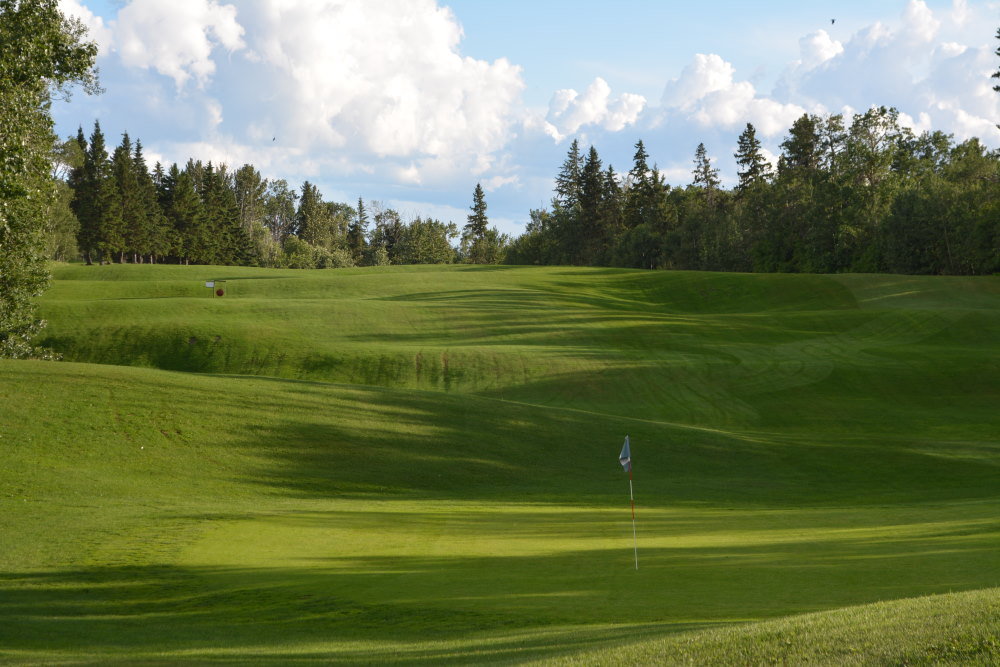
The greens and fairways as viewed from the clubhouse didn’t appear all that well-groomed. Then again, I’m sure national parks don’t use herbicides and fertilizers like typical golf courses anymore. This is especially true of ones located immediately adjacent to nesting grounds for untold numbers of birds.
 They do have carts available and I’m sure it makes for a delightful half-round of golf for modest golfers or those looking to learn. And what the course does lack in stunning beauty it makes up for in camper conveniences.
They do have carts available and I’m sure it makes for a delightful half-round of golf for modest golfers or those looking to learn. And what the course does lack in stunning beauty it makes up for in camper conveniences.
 With no store in the campground, the clubhouse at the golf course is your only source for ice and junk food treats. They have slushie machines and a cooler of popsicles as well as a small selection of chocolate bars and candy. Additionally, there is a café which sells coffee, burgers, fries, perogies, and a couple breakfast selections. This is all an easy walk from the campground or day use area and we did so each day. Mostly for the ice. Mostly.
With no store in the campground, the clubhouse at the golf course is your only source for ice and junk food treats. They have slushie machines and a cooler of popsicles as well as a small selection of chocolate bars and candy. Additionally, there is a café which sells coffee, burgers, fries, perogies, and a couple breakfast selections. This is all an easy walk from the campground or day use area and we did so each day. Mostly for the ice. Mostly.
So how would I rate our stay at Astotin Lake Campground in Elk Island National Park? That all depends on what you are expecting. As a day use area it’s fantastic. As a tent or small camper weekend getaway, it’s delightful. If you have a beast of an RV, you’re going to have to look elsewhere.
For our likes and expectations, I give it 4 baby dill pickles out of 5 but fully recognize it won’t be for everyone. I’ll admit the odd orientation of campsites and lack of privacy wasn’t the most endearing and I would have liked power, at least. I mean, it’s right there for the bathrooms and picnic shelters.
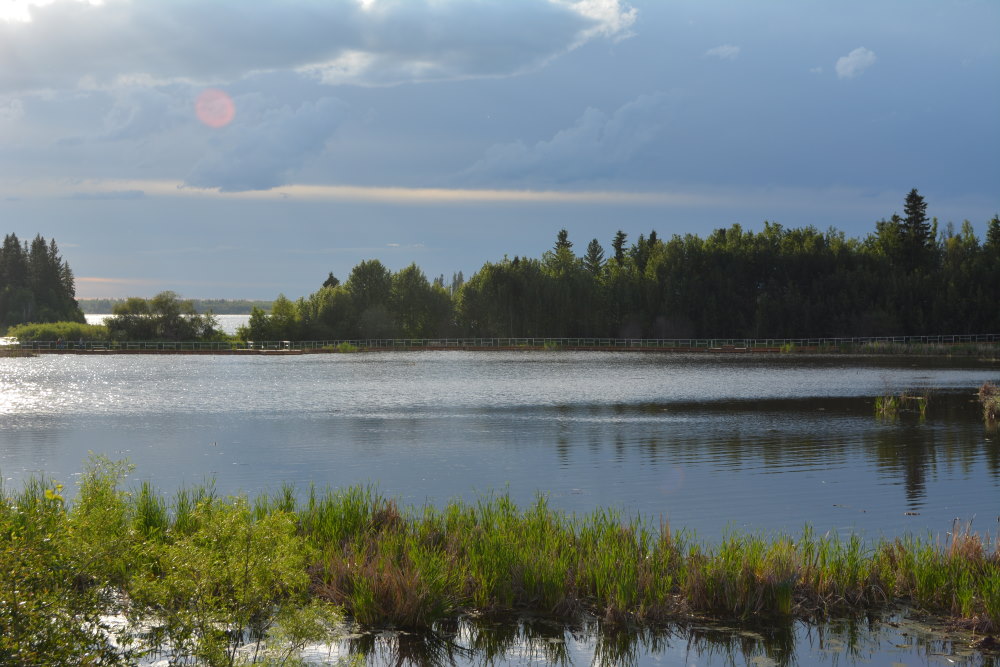
The playgrounds are great and those large picnic shelters are wonderful. For a small park, the programs are plentiful and informative. I would easily go back for a day trip or another camping trip. But good grief, the RV campground and the group site are terrible. To anyone looking to use those specific facilities, I’d rate the place a 1 out of 5. Terribly disappointing, especially considering how good everything else is at Elk Island National Park.

